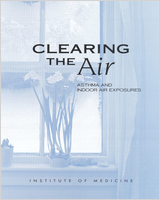From: EXECUTIVE SUMMARY

Clearing the Air: Asthma and Indoor Air Exposures.
Institute of Medicine (US) Committee on the Assessment of Asthma and Indoor Air.
Washington (DC): National Academies Press (US); 2000.
Copyright 2000 by the National Academy of Sciences. All rights reserved.
NCBI Bookshelf. A service of the National Library of Medicine, National Institutes of Health.